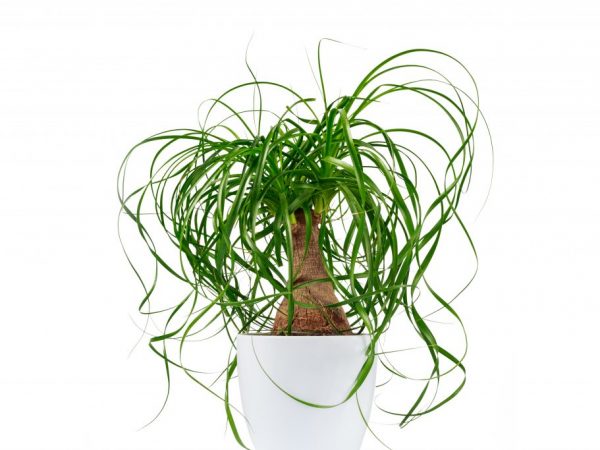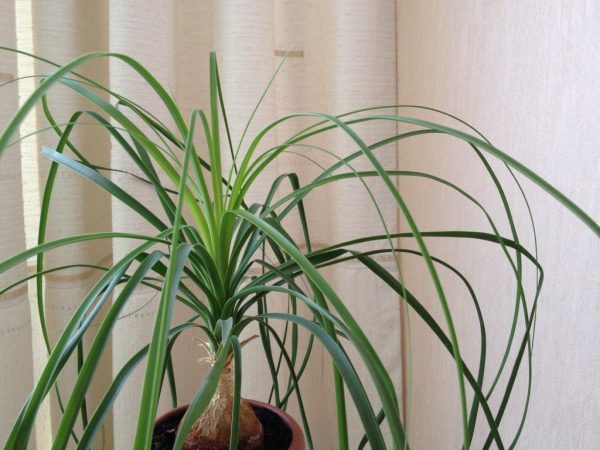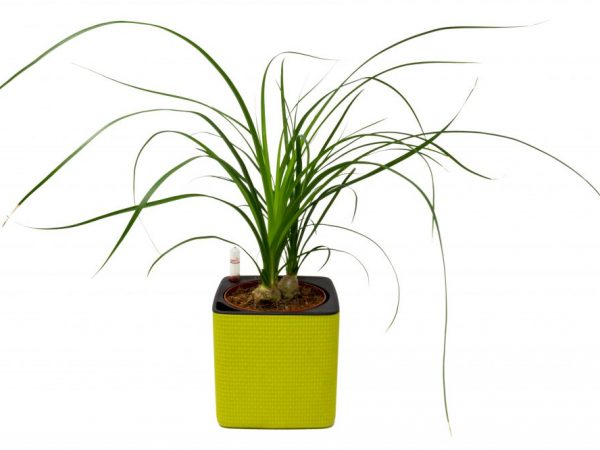Bokarnea bent - domesticated culture
Bocarnea is a genus of tropical perennials of the Nolinovye subfamily. In the wild, it grows only in the southern regions of Mexico and America. Certain species are domesticated and cultivated as ornamental houseplants - these include bokarnea bent.

Bokarnea bent - domesticated culture
Botanical characteristic
Bocarnea, or Nolina, in natural growing conditions reaches a height of up to 10 m with a trunk diameter of about 1 m.
When grown at home, it grows up to 2 m. It looks like a palm tree.
Because of its unusual appearance among the people, beaucarnea received the names of the elephant leg, bottle tree and ponytail.
Description:
- the trunk looks like a swollen bottle, has a thickening in the lower part intended for the accumulation of moisture and nutrients, is covered with cracked bark, the color is light brown or grayish;
- the root system is predominantly developed in breadth.
- leaves are narrow, erect or falling, length 0.3-1.0 m, pointed ends, hard leathery surface, longitudinal veins are clearly expressed, the color is dark green;
- blooms in small inflorescences, cream shade, with a strong pleasant smell;
- the seeds are brown, rounded, flat.
It blooms only in the wild or in greenhouse conditions. Flowering is observed in summer at high temperatures.
Varieties
The genus has about 30 subspecies, including several domesticated varieties.
- N.recurvata, folded back. A common cultivar grown at home. Recurvata has a typical stem with a well-formed caudex. The branching is minimal. The crown is formed by a rosette of long foliage with a leathery surface structure.
- N.longifolia, long-leaved. It is rarely found in home floriculture. It features a powerful trunk covered with cork-like bark. It has large leaves, which, as they die off, close the trunk in the form of a skirt. Unlike the bent one, the long-leaved branching is increased.
- N.lindheimeriana, Lindmeyer cultivar. Most similar to the description with a palm tree. Reaches the highest possible height. Dark green leafy crowns are formed on long, thin shoots growing from caudex. The leaves are sinuous, sometimes dropping to the surface of the earth.
- N. matapensis, matapian. It is distinguished by its small height (no more than 1.8 m) and a very dense wide crown.
Purchase and adaptation rules
The best time to buy a bottle tree is in spring. During the spring-summer season, it manages to go through the adaptation period and prepare for the cold season.
The price depends on the variety and, on average, is about 1000 rubles.
When purchasing, pay attention to the appearance of the plant. Healthy:
- foliage of rich color, without spots, signs of diseases and pests;
- root system without damage.
A newly purchased homemade succulent needs a two-week quarantine, during which it is not fed or transplanted.
Growing conditions
Desert succulents are not picky about conditions and will survive with minimal maintenance.
He prefers a lighted spot on the south or southwest windowsill.
- In its natural environment, it grows on stony, barren land.
- Suitable for indoor cultivation is a light water-absorbing and breathable substrate for succulents.
Expanded clay or gravel is added to the finished soil to increase aeration.
You can prepare a soil mixture yourself by mixing clay soil, humus, coarse sand, small pebbles (expanded clay mixture) in proportions 1: 1: 0.5: 0.5.

Bocarnea needs a special primer
For preventive protection against the development of fungal infections, it is recommended to add charcoal or activated carbon in a small amount.
Humidity
Moisture readings are not particularly important for a desert plant. The flower culture does not require spraying. Moistening through foliage is possible, avoiding contact with the trunk.
Temperature
Nolina is a desert perennial. Optimum temperature for home growing:
- in summer - 20-25 ° С;
- in winter - not lower than 10 ° С.
In the summer season, it is recommended to take it to the open air with protection from precipitation and drafts.
Lighting
The excess of light is not afraid, but it is susceptible to the direct sun. On the contrary, in the absence of sufficient illumination, it fades and dies. To avoid twisting the stem, the flowerpot should be periodically turned clockwise 45 ° C every 1-2 weeks.
The required duration of daylight hours is 12 or more hours.
Care
Watering
Thanks to the caudescu, the succulent is able to easily withstand short-term droughts in dry air and needs limited watering. Bocarnea is watered in the summer up to half a month, in winter it is reduced to a minimum or stopped altogether, because the plant receives moisture from the surrounding atmosphere through the foliage.
Nolina needs watering as soon as her trunk begins to wrinkle and become less elastic.
Overflow susceptible. As the amount of moisture applied is reduced, the thickening becomes narrower in diameter. With an increase in the volume of irrigation procedures, the stem base expands. Because of this feature, you can grow Nolina of the desired width with a large bulb and sparse foliage, or with a thin trunk and rich crown.
Top dressing
Bokarnea is fed only at the stage of active vegetation, mainly in summer. Starting in autumn, feeding is reduced to a minimum. In winter, the houseplant is not fertilized. In this case, the concentration provided in the instructions is reduced by 3-4 times. The frequency of application is up to once every 3 weeks.
Transfer
For planting a bottle tree with shallow roots, a small but wide pot with drainage holes, with a 1/3 height / width ratio, is suitable. Drainage should take up at least a third of the pot's volume.
The young plant is transplanted annually to ensure the full development of the root system. An adult succulent plant requires a transplant every 3-4 years. For an indoor flower, which is already about 20 years old, it is necessary to replace the surface layer of the earth by 5 cm in depth.

A young plant is transplanted once a year.
Transplant technology:
- they take out a bokarney from an old pot;
- the root system is examined for decay, if there are signs of overflow, they dry for several hours, the decayed fragments are cut off and sprinkled with crushed activated or charcoal;
- a drainage layer is organized in a pot container, a substrate is poured on top, and a hill is formed in the central part;
- the flower is set in the center, the roots are straightened, covered with soil, leaving the entire trunk on the surface, the voids are tamped;
- for stability, they are lined with small stones;
- put in partial shade for 2-3 days, do not water.
To increase decorativeness, flower growers often use group planting, planting 3-5 plants of the same age in one pot at once. Succulents are planted so that their trunks touch, because as they developed, they grew together into a single base with several tops.
Pruning
The flower culture does not need pruning and crown formation, because branching is rarely observed during home cultivation. Cut off damaged shoots and wilted foliage.
Reproduction methods
At home, Nolina is propagated by vegetative methods (cuttings) and the generative method (seed).
Seminal
For seed reproduction, the bottom of a wide container is laid out with a sand mixture 2-3 cm thick. A similar layer of light soil is poured on top, then another 1-2 cm of sand.
The seeds are soaked in an Epin or Zircon solution for 5-10 hours, laid out on a substrate at a distance of 2 cm, covered with plastic wrap and placed in a place with a temperature of 25 ° C, airing the plantings daily, opening the film shelter.
Only high-quality planting material is suitable for seed propagation. Even high-value seeds germinate very unevenly.
As the roots grow, they are directed downward with a toothpick, without separating the seed from the seedling. Approximately 30 days after germination, the film is replaced with an upside-down plastic container in which holes have been made.
When the shoots reach 2 months, they are dived, and transplanted into independent pots six months later.
Cuttings
For reproduction, lateral cuttings are taken, which rarely grow back under home breeding conditions, therefore this method is rarely used by flower growers.
Technology:
- the sprout is cut from the mother plant to a length of up to 10 cm;
- the stalk is cleaned of the lower foliage;
- the planting cut is treated with a rooting stimulator;
- planted at an angle in a soil mixture of sand, vermiculite and peat, taken in equal proportions;
- cover with a glass jar on top, creating a greenhouse effect;
- the pot is placed in a well-lit place at a temperature of 25 ° C, periodically ventilating the greenhouse and moistening the soil;
- the shelter is removed when a pair of young leaves appear on the handle;
- provide care as for an adult plant.
Treatment of diseases and pests

With proper care, the flower rarely gets sick.
The main problems with home growing of bokarnea are associated with a violation of care.
| View | Ways to fight |
| Loss of elasticity of foliage. Caused by prolonged exposure to dry air combined with elevated temperatures. | The humidity is increased. The plant is sprayed. Temperature readings are reduced. |
| Shrinking of the trunk and drying of the tips of the leaves. The reason lies in the lack of watering. | The succulent is watered. |
| The leaf plates are repainted brown, dry, fall off, the base rots. Overflow related. | Watering is normalized. In a critical situation, the flower culture is transplanted into a fresh substrate, after cutting off the rotten areas. |
| Slow growth. Signals about nutritional deficiency. | Nitrogen-containing dressings are introduced. |
| The trunk does not develop in thickness. More often it occurs due to a lack of illumination in conjunction with overflow. | Reduce watering and increase lighting. In winter, the lack of light is compensated by the use of artificial sources - fluorescent lamps. |
| Mealybug. Leads to the appearance of white bloom on the leaves. | The plant is treated with an insecticide, for example, Aktara. |
| Spider mite. It is easy to recognize by the distribution of the non-vegetative part of the white web. Distributed in dry air. | The succulent is sprayed with an insecticidal preparation, for example, Actellik. |
| Shield. Causes yellowing and wilting of foliage. | The leaf mass is wiped with soapy water (50 g per 1 liter of water). In case of mass defeat, additional treatment is carried out with one of the insecticides. |

